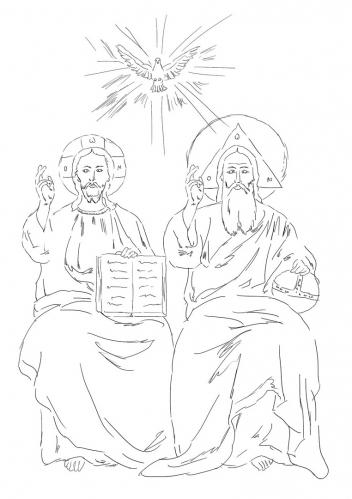



The Holy Trinity
Byzantine and Post-Byzantine art tried to find solutions in order to avoid the antropomorhic representation of God the Father, using the image of Jesus Christ, as part of the Holy Trinity, or treating the subject allegorically. The scene of "Abraham and the Three Angels" was the most used image for this allegorical and anagogic approach.
Influenced by Western art, mainly Baroque, anthropomorphic representations of God the Father could be encountered in Orthodox iconography and the theme became generally accepted in the 19th. century, although there were also earlier occurrences.
Compositionally, the themed illustration includes two enthroned characters, God the Father being usually placed to the left side of Jesus Christ. In most of the cases the thrones are hardly visisble, as they are completely covered by a multitude of characters and seemed to be supported by the clouds underneath. Both characters are clad in long tunics and draped chitons. No clear symbolism of the vestments colors could be detected. Considering the facial details and the attributes: the halo and regalia, it can be stated that the characters are depicted according to the canons for God the Father (see canon) and Christ Pantokrator (see canon).
The Holy Spirit (see canon) is usually depicted as soaring between the two enthroned characters.
The scene is placed against a neutral backgound, gold in most of the cases, in order to stress the atemporal and aspatial characters of the scene.
Byzantine and Post-Byzantine art tried to find solutions in order to avoid the antropomorhic representation of God the Father, using the image of Jesus Christ, as part of the Holy Trinity, or treating the subject allegorically. The scene of "Abraham and the Three Angels" was the most used image for this allegorical and anagogic approach.
Influenced by Western art, mainly Baroque, anthropomorphic representations of God the Father could be encountered in Orthodox iconography and the theme became generally accepted in the 19th. century, although there were also earlier occurrences.
Compositionally, the themed illustration includes two enthroned characters, God the Father being usually placed to the left side of Jesus Christ. In most of the cases the thrones are hardly visisble, as they are completely covered by a multitude of characters and seemed to be supported by the clouds underneath. Both characters are clad in long tunics and draped chitons. No clear symbolism of the vestments colors could be detected. Considering the facial details and the attributes: the halo and regalia, it can be stated that the characters are depicted according to the canons for God the Father (see canon) and Christ Pantokrator (see canon).
The Holy Spirit (see canon) is usually depicted as soaring between the two enthroned characters.
The scene is placed against a neutral backgound, gold in most of the cases, in order to stress the atemporal and aspatial characters of the scene.




